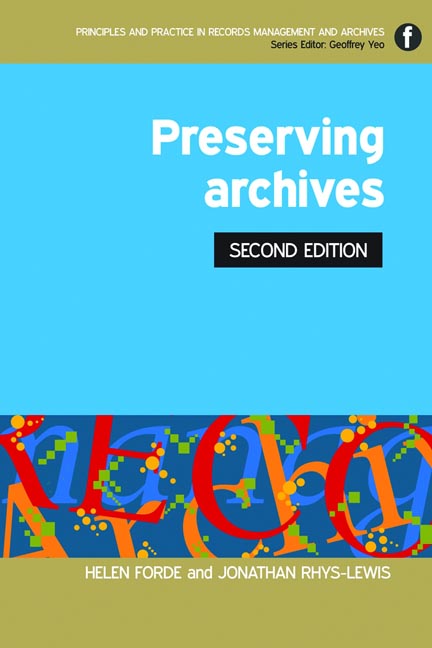Book contents
- Frontmatter
- Contents
- Introduction to the series Geoffrey Yeo
- Preface to the Second Edition
- Acknowledgements
- 1 Introducing archive preservation
- 2 Understanding archival materials and their characteristics
- 3 Managing digital preservation
- 4 Archive buildings and their characteristics
- 5 Safeguarding the building and its contents
- 6 Managing archival storage
- 7 Managing risks and avoiding disaster
- 8 Creating and using surrogates
- 9 Moving the records
- 10 Exhibiting archives
- 11 Handling the records
- 12 Managing a pest control programme
- 13 Training and the use of volunteers
- 14 Putting preservation into practice
- Appendices
- Bibliography
- British and international standards relating to archive preservation
- Index
10 - Exhibiting archives
Published online by Cambridge University Press: 09 June 2018
- Frontmatter
- Contents
- Introduction to the series Geoffrey Yeo
- Preface to the Second Edition
- Acknowledgements
- 1 Introducing archive preservation
- 2 Understanding archival materials and their characteristics
- 3 Managing digital preservation
- 4 Archive buildings and their characteristics
- 5 Safeguarding the building and its contents
- 6 Managing archival storage
- 7 Managing risks and avoiding disaster
- 8 Creating and using surrogates
- 9 Moving the records
- 10 Exhibiting archives
- 11 Handling the records
- 12 Managing a pest control programme
- 13 Training and the use of volunteers
- 14 Putting preservation into practice
- Appendices
- Bibliography
- British and international standards relating to archive preservation
- Index
Summary
Introduction
Why put irreplaceable material at risk? The main answer to this is that exhibitions are a major way of promoting access to archival material and involving the public and staff in a topic of mutual interest. All the activities connected with exhibitions, such as the publication of catalogues, production of facsimiles for sale, group visits and publicity, are major concerns of those involved with outreach. For those involved with preservation the essential requirement is to match these needs with adequate security and preservation standards, while not inhibiting or dampening the enthusiasm and talent of colleagues. The crucial factors are collaboration and understanding; exhibitions involve planning and co-operating, compromise and change. Once others understand the concerns of all, the process becomes easier but communication in the first instance is vital. If the parameters relating to standards of exhibition are laid out at the very beginning much less can go wrong. This chapter covers:
• minimizing the associated risks
• policies, standards and guidelines for exhibitions
• managing the care of documents in exhibitions
• planning and preparing for an exhibition.
How can the overall risk be minimized?
The easiest way of minimizing the risk is to set out an exhibition policy and procedure with which everyone agrees. This may involve not only a simple statement of aims for internal use but also a more detailed policy and set of procedures for external loans. The organization will benefit from being very clear about what it will and will not display, outside borrowers will understand the limits of what can be borrowed and why, and staff will appreciate the concerns of other colleagues. Drawing up such a document may take some time, but plenty of examples are available to suggest the main headings. It is very unwise to wait until an exhibition is suggested; policies developed in a hurry under the pressure of a particular project are never satisfactory. Consider:
• the purposes of exhibiting archival material and the authority by which the archive does so
• the scope of exhibitions and the capacity of the organization to mount them
• whether the policy of the organization is to display originals or facsimiles
• the location – whether on the premises or elsewhere.
- Type
- Chapter
- Information
- Preserving Archives , pp. 159 - 174Publisher: FacetPrint publication year: 2013

